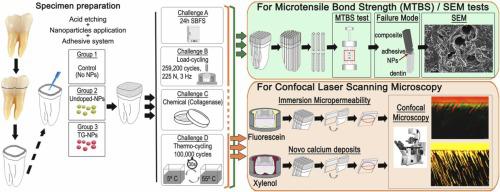当前位置:
X-MOL 学术
›
Dent. Mater.
›
论文详情
Our official English website, www.x-mol.net, welcomes your feedback! (Note: you will need to create a separate account there.)
Dentin remineralization using a stimuli-responsive engineered small molecule GSK3 antagonists-functionalized adhesive
Dental Materials ( IF 5 ) Pub Date : 2023-12-19 , DOI: 10.1016/j.dental.2023.12.010 Manuel Toledano , Fátima S. Aguilera , Enrique Fernández-Romero , Alejandro JS. Lagos , Marco Bonilla , Christopher D. Lynch , Raquel Osorio
Dental Materials ( IF 5 ) Pub Date : 2023-12-19 , DOI: 10.1016/j.dental.2023.12.010 Manuel Toledano , Fátima S. Aguilera , Enrique Fernández-Romero , Alejandro JS. Lagos , Marco Bonilla , Christopher D. Lynch , Raquel Osorio

|
Tideglusib has shown great performance in terms of dentin regenerative properties. This study aims to evaluate bonding ability, of demineralized dentin infiltrated with polymeric nanoparticles (NPs) doped with tideglusib (TG) (TG-NPs). Dentin conditioned surfaces were infiltrated with NPs and TG-NPs. Bonded interfaces were created and stored for 24 h and then submitted to mechanical, chemical and thermal challenging. The resin-dentin interface was evaluated through a doubled dye fluorescent technique and a calcium chelator fluorophore under a confocal laser scanning microscopy, and by field emission scanning electron microscopy. Dentin surfaces treated with TG-NPs and load cycled produced higher bond strength than the rest of the groups. Immersion of dentin specimens treated with undoped-NPs in collagenase solution attained the lowest microtensile bond strength (MTBS) values. Both porosity and nanoleakage decreased when dentin was infiltrated with TG-NPs, that revealed strong signals of xylenol orange stain at both hybrid layer and dentinal tubules. The presence of NPs, in general, inducted the presence of mineralized interfaces after mechanical loading and thermocycling. Nanoparticles doped with tideglusib promoted the highest dentin bonding efficacy among groups, as they facilitated the maximum bond strength values with creation of mineral deposits at the hybrid layer and dentinal walls. Tideglusib enabled scarce porosity, nanoleakage and advanced sealing among dentin groups. Doping hydrophilic polymeric NPs with tideglusib, infiltrated in etched dentin represents a reproducible technique to create reparative dentin at the resin-dentin interface, by inducing therapeutic bioactivity.
中文翻译:

使用刺激响应工程小分子 GSK3 拮抗剂功能化粘合剂进行牙本质再矿化
Tideglusib 在牙本质再生特性方面表现出了出色的性能。本研究旨在评估掺杂有 tigeglusib (TG) 的聚合物纳米颗粒 (NP) (TG-NP) 浸润的脱矿牙本质的粘合能力。牙本质调理表面用 NP 和 TG-NP 渗透。创建粘合界面并保存 24 小时,然后接受机械、化学和热挑战。树脂-牙本质界面通过双染料荧光技术和钙螯合剂荧光团在共焦激光扫描显微镜下以及场发射扫描电子显微镜进行评估。用 TG-NP 处理并循环负载的牙本质表面比其他组产生更高的粘合强度。将用未掺杂的纳米粒子处理的牙本质样本浸入胶原酶溶液中获得了最低的微拉伸粘合强度(MTBS)值。当牙本质被 TG-NP 浸润时,孔隙率和纳米渗漏均下降,这表明混合层和牙本质小管处的二甲酚橙染色信号很强。一般来说,纳米颗粒的存在会在机械加载和热循环后诱导矿化界面的存在。掺杂有 tidglusib 的纳米颗粒促进了各组中最高的牙本质粘合功效,因为它们通过在混合层和牙本质壁上形成矿物质沉积物来促进最大粘合强度值。Tideglusib 实现了牙本质组之间的稀缺孔隙率、纳米渗漏和高级密封。将亲水性聚合物纳米颗粒与 tidglusib 混合,渗透到蚀刻牙本质中,代表了一种可重复的技术,通过诱导治疗生物活性,在树脂-牙本质界面上创建修复性牙本质。
更新日期:2023-12-19
中文翻译:

使用刺激响应工程小分子 GSK3 拮抗剂功能化粘合剂进行牙本质再矿化
Tideglusib 在牙本质再生特性方面表现出了出色的性能。本研究旨在评估掺杂有 tigeglusib (TG) 的聚合物纳米颗粒 (NP) (TG-NP) 浸润的脱矿牙本质的粘合能力。牙本质调理表面用 NP 和 TG-NP 渗透。创建粘合界面并保存 24 小时,然后接受机械、化学和热挑战。树脂-牙本质界面通过双染料荧光技术和钙螯合剂荧光团在共焦激光扫描显微镜下以及场发射扫描电子显微镜进行评估。用 TG-NP 处理并循环负载的牙本质表面比其他组产生更高的粘合强度。将用未掺杂的纳米粒子处理的牙本质样本浸入胶原酶溶液中获得了最低的微拉伸粘合强度(MTBS)值。当牙本质被 TG-NP 浸润时,孔隙率和纳米渗漏均下降,这表明混合层和牙本质小管处的二甲酚橙染色信号很强。一般来说,纳米颗粒的存在会在机械加载和热循环后诱导矿化界面的存在。掺杂有 tidglusib 的纳米颗粒促进了各组中最高的牙本质粘合功效,因为它们通过在混合层和牙本质壁上形成矿物质沉积物来促进最大粘合强度值。Tideglusib 实现了牙本质组之间的稀缺孔隙率、纳米渗漏和高级密封。将亲水性聚合物纳米颗粒与 tidglusib 混合,渗透到蚀刻牙本质中,代表了一种可重复的技术,通过诱导治疗生物活性,在树脂-牙本质界面上创建修复性牙本质。



























 京公网安备 11010802027423号
京公网安备 11010802027423号